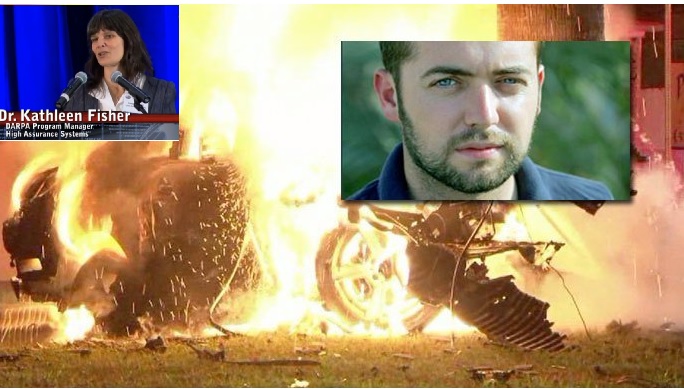June 25, 2013
Former U.S. National Coordinator for Security, Infrastructure Protection, and Counter-terrorism Richard Clarke told The Huffington Post on Monday that the fatal crash of journalist Michael Hastings’ Mercedes C250 coupe last week is “consistent with a car cyber attack.”
“There is reason to believe that intelligence agencies for major powers” — including the United States — know how to remotely seize control of a car,” Clarke said.
On Saturday, Infowars.com posted a video of a talk presented by Dr. Kathleen Fisher, a program manager for DARPA, the Defense Advanced Research Projects Agency, an agency of the United States Department of Defense responsible for the development of new technologies. Fisher admitted that the Pentagon has researched remotely controlling cars through hacking on board computers.
- NewsRescue-Your Modern Car Can Be Hacked Into And Remotely Driven Or Crashed–DARPA: Hastings Accident
In 2011, Car and Driver magazine published an article substantiating the Pentagon research. “Currently, there’s nothing to stop anyone with malicious intent and some computer-programming skills from taking command of your vehicle. After gaining access, a hacker could control everything from which song plays on the radio to whether the brakes work,” writes Keith Barry, citing research conducted by the Center for Automotive Embedded Systems Security, a partnership between the University of California San Diego and the University of Washington.
“What has been revealed as a result of some research at universities is that it’s relatively easy to hack your way into the control system of a car, and to do such things as cause acceleration when the driver doesn’t want acceleration, to throw on the brakes when the driver doesn’t want the brakes on, to launch an air bag,” Clarke told The Huffington Post. “You can do some really highly destructive things now, through hacking a car, and it’s not that hard.”
Clarke was careful not to directly implicate the government in hacking Hastings’ car. “So if there were a cyber attack on the car — and I’m not saying there was,” he said, “I think whoever did it would probably get away with it.”
He also put credence in the FBI’s claim – despite claims to the contrary by associates of the writer – that the agency was not investigating him. “I believe the FBI when they say they weren’t investigating him,” said Clarke. “That was very unusual, and I’m sure they checked very carefully before they said that.”
“I’m not a conspiracy guy. In fact, I’ve spent most of my life knocking down conspiracy theories,” said Clarke. “But my rule has always been you don’t knock down a conspiracy theory until you can prove it [wrong]. And in the case of Michael Hastings, what evidence is available publicly is consistent with a car cyber attack. And the problem with that is you can’t prove it.”
Despite the overwhelming evidence that Michael Hastings was targeted and assassinated for his journalism – most notably his story resulting in the fall of Gen. Stanley McChrystal and remarks on NSA surveillance – the establishment media continues to portray the attack on Hastings as the delusional meanderings of conspiracy theorists. Clarke’s comments serve as the latest pièce de résistance in an unfolding drama revealing just how far the government will go to silence critics and truth tellers.
Prior to his murder, Hastings said the Obama administration had declared war on the press. His desire to go into hiding – expressed in an email mere hours before his assassination – demonstrates the ability of the government to monitor opponents by using a well-developed NSA surveillance grid and take executive action against investigative journalists and others who dare to stand up to the national security state.
